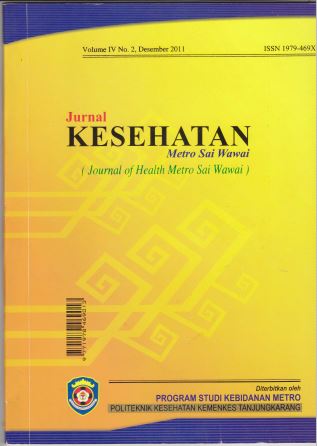PENGARUH LATIHAN RANGE OF MOTION (ROM) ANKLE TERHADAP PROSES PENYEMBUHAN ULKUS KAKI DIABETIK DI RSUD Dr. Hi. ABDUL MOELOEK DAN RSUD JENDERAL A. YANI PROPINSI LAMPUNG
DOI:
https://doi.org/10.26630/jkm.v4i2.1160Keywords:
Ulkus kaki diabetik, latihan ROM ankleAbstract
Ulkus kaki diabetik adalah komplikasi kronik diabetes melitus yang mengakibatkan kerusakan kulit yang dapat meluas ke tendon, otot, tulang atau persendian. Ulkus kaki, infeksi, neuroarthropati dan penyakit arteri perifer mengakibatkan gangren dan amputasi ekstremitas bagian bawah. Tujuan penelitian ini untuk mengetahui pengaruh latihan ROM ankle terhadap proses penyembuhan ulkus kaki diabetik di rumah sakit di propinsi Lampung. Penelitian ini menggunakan desain kuasi eksperimen pre post test dengan kelompok kontrol, melibatkan 7 responden kelompok intervensi dan 7 responden kelompok kontrol. Teknik pengambilan sampel dengan non probability consecutive sampling. Penelitian ini menggunakan t test, diperoleh hasil adanya perbedaan yang signifikan rata-rata skor penyembuhan ulkus kaki diabetik antara kelompok intervensi dan kelompok kontrol setelah dilakukan latihan ROM ankle (p= 0,001; α = 0,05 ). Demikian juga terbukti tidak ada hubungan antara lama sakit DM (p = 0,656 ; α = 0,05), GDN (p = 0,648 ; α = 0,05), GDPP (p = 0,883 ; α = 0,05) dan infeksi ulkus (p = 1,000; α = 0,05) dengan skor penyembuhan ulkus kaki diabetik. Peneliti memberikan saran agar latihan ROM ankle dapat diterapkan pada perawatan ulkus kaki diabetik sesuai dengan formula yang ada. Penelitian lebih lanjut perlu dilakukan dengan jenis gerakan yang lain, melibatkan tidak hanya sendi ankle. Selain itu dilakukan penelitian dengan jumlah sampel yang lebih besar.References
Altman, G. (2004). Delmar’s fundamental and advanced nursing skills. 2nd edition. New York: Thomson Delmar learning.
American Diabetes Association. (2011). Diagnosis and classification of diabetes mellitus. Diabetes care, 34 (1), S62 – S69.
Astrid, M. (2008). Pengaruh ROM terhadap kekuatan otot luas gerak sendi dan kemampuan fungsional pasien stroke di RS Sint Carolus Jakarta. Thesis: Tidak dipublikasikan
Baranoski, S. & Ayello, E.A. (2008). Wound care essentials practice principle. 2nd edition. Wolters Kluwer Lippincott William & Wilkins: USA
Benbow, M .(2009). The management of leg ulceration. Practice nursing, 20 (3), 140 - 146.
Bentley, J. & Foster, A. (2007). Multidiciplinary management of diabetic foot ulcer (clinical review) http://web.ebscohost.com. diakses Tgl. 13-3-2011
Bentley, J. & Foster, A. (2008). Management of the diabetic foot ulcer: Exercising control.
http://web.ebscohost.com. diakses Tgl.13-3-2011
Boulton, A. J.M. (2004). The diabetic foot: From art to science. The 18th camillo golgi lecture. Diabetologia, 47, 1343–1353
Bowman, A.M. (2008). Promoting safe exercise and foot care for clients with type 2 diabetes.
http://web.ebscohost.com. diakses Tgl. 8-2-2011
Bryant, R. & Nix, D. (2007). Acute and chronic wound current management concept. 3rd Edition. St. Louis: Mosby Elsevier.
Cade, W.T. (2008). Diabetes related microvascular and macrovascular disease in the physical therapy setting. Physical theraphy, 88 (11), 1322– 1335.
Cahyono, J.B. (2007). Manajemen ulkus kaki diabetik (pdf). http://www.dexa-medica.com. diakses Tgl.9-2-2011
Clayton, Warren, Jr. & Elasy, T.A. (2009). A review of the pathophysiology, classification, and treatment of foot ulcers in diabetic patients. Clinical diabetes, 27 (2), 52 – 58.
Copeland, R.J., Crank, H., Hall, A., & Milbourn, A. (2010). Be active promoting physical activity in overweight people. Practice nursing, 21 (11), 569 – 573.
Craven, R. F., & Hirnle, C. (2007). Fundamentals of nursing human health and function. 5th edition. Lippincott William Wilkins: Philadelphia.
Dahlan, M.S. (2006). Langkah-langkah membuat proposal penelitian bidang kedokteran dan kesehatan. Seri 3. Jakarta: Sagung seto
Dahlan, M.S. (2006). Besar sampel dalam penelitian bidang kedokteran dan kesehatan. Seri 2. Jakarta: PT Arkarnas
Dahlan, M.S. (2008). Statistik untuk kedokteran dan kesehatan. Edisi 3. Jakarta: Salemba medika
Delmas, L. (2006). Best practice in the assessment and management of diabetic foot ulcers. Rehabilitation nursing, 31 (6). 228 – 234.
Ellis, J.R., & Bents, P.M. (2007). Modules for basic nursing skills. 7th edition. Philadelphia: Lippincott William Wilkins
Erlina, L. (2008). Pengaruh senam diabetik terhadap kadar glukosa darah pada pasien DM tipe II di perkumpulan pasien diabetes RSU unit swadana Daerah Kabupaten Sumedang. Thesis: tidak dipublikasikan.
Flahr, D. (2010). The effect of nonweight-bearing exercise and protocol adherence on diabetic foot ulcer healing a pilot study. Journal wound management, 56 (10), 40 – 50.
Frosig, Christian, Richter, & Erik, A . (2009). Improved insulin sensitivity after exercise focus on insulin signaling. Obesity journal, 17 (3), S1-S20.
Frykberg, R.G., Zgonis, T., Armstrong., D.G., Driver, V.R., Giurini, J.M., Kravitz, S.R., Landsman, A.S., et al. (2006). Diabetic foot disorders a clinical practice guidelines (2006 revision). The journal of foot & ankle surgery, 45 (5). S1– S66.
Frykberg, R.G. (2002). Diabetic foot ulcers pathogenesis and management. American family physician, 66 (9), 1655 – 1662.
Gershater, M.A. Londahl, M., Nyberg, P., Larsson, J., Thorne, J., Eneroth, M., & Apelqvist, J. (2009). Complexity of factors related to outcome of neuropathic and neuroischaemic/ischaemic diabetic foot ulcers: A cohort study. Diabetologia, 52, 398–407.
Giacomozzi, C., D'Ambrogi, E., Cesinaro, S., Macellari, V., & Uccioli., L. (2008). Muscle performance and ankle joint mobility in long term patients with diabetes. BMC musculoskeletal disorders, 99 (9).
Goldsmith, J.R., Lidtke, RH., & Shott, S. (2002). The effects of range of motion therapy on the plantar pressures of patients with diabetes mellitus. Journal of the American podiatric medical association, 92 (9), 483-490.
Gulve, E.A. (2008). Exercise and glycemic control in diabetes: Benefits, challenges, and adjustments to pharmacotherapy. Physical therapy, 88, 1297-1321.
Guo, S., & DiPitrio, L.A. (2010). Factors affecting wound healing. J dent res, 89(3), 219-229.
Harkreader, H., Hogan, M.A., & Thobaben, M. (2007). Fundamentals of nursing caring and clinical judgment. 3rd edition. St. Louis: Saunders Elsevier
Ika ,Y.W. (2010). Pengaruh latihan gerak sendi bawah aktif (active lower range of motion exercise) terhadap tanda dan gejala neuropati diabetikum pada penderita DM tipe II di PERSADIA unit RSU Dr Sutomo Surabaya. Thesis: Tidak dipublikasikan
Janice, H., Lagden, K., McLaren, M. A., O’Sullivan, D., Orr, L., Houghton, P.E., & Woodbury, M.G. (2010). A prospective, multicenter study to validate use of the pressure ulcer scale for healing (PUSH©) in patients with diabetic, venous, and pressure ulcers. Ostomy wound management, 56 (2), 26-36.
Jennifer,J.E.,Gideonsen, Mark D.,&Gregory,P.M. (2008). Practical konsideration of using topical honey for neurophatic diabetic foot ulcers: A review. Winconsin medical journal,107 (4).187–190.
Jull, A., Parag, V., Walker, N., Maddison, R., Kerse, N., & Johns, T. (2009). The prepare pilot RCT of home based progressive resistance exercises for venous leg ulcers. Journal of wound care, 18 (12). 497 – 503.
Kozier, B., Erb, G., Berman, A., & Synder, SJ. (2004). Fundamentals of nursing concepts, process, and practice. 7th edition. New Jersey: Pearson Prantice Hall
Leaper,D.(2007).Perfusion, oxygenation and warming.International wound journal, 4 (3), 4-8
LeMaster, J.W., Mueller, M.J., Reiber, G.E., Mehr, D.R., Richard, W.M & Conn, V.S. (2008). Effect of weight bearing activity on foot ulcer incidence in people with diabetic peripheral neuropathy feet first randomized controlled trial. Physical therapy, 88(11), 1385 - 1397
Liu, Y., Danqing, M., Thyra, B., Vanessa, N., Stephen, MT., & Dennis, KY . (2009). Increased matrix metalloproteinase-9 predicts poor wound healing in diabetic foot ulcers. Diabetes care, 32, 117–119
Loughlin, D.T., & Artlett, Carrol, M. (2009). 3-deoxyglucosone-collagen alters human dermal fibroblast migration and adhesion: Implications for impaired wound healing in patients with diabetes. Wound repair and regeneration, 17, 739–749
McLenan., Min D., & Yue D.K. (2008). Matrix metalloproteinases and their roles in poor wound healing in diabetes. Wound practice and research, 16 (3). 116 – 121.
Molan, P.C., & Betts, J.A. (2008). Using honey to heal diabetic foot ulcers. http://researchcommons. waikato.ac.nz. diakses Tgl. 1 April 20011
Muller, M., Trocme, C., Lardy, B., Morel, F., Halimi, S., & Benhamou, P.Y. (2007). Matrix metalloproteinases and diabetic foot ulcers: The
ratio of MMP-1 to TIMP-1 is a predictor of wound healing. Diabetic medicine, 25, 419–426
Nazarko, L . (2010). Treatment of type 2 diabetes. British journal of healthcare assistants, 04 (3), 124 – 129.
Norwood, S. ( 2000). Research strategies for advanced practice nurses. New Jersey: Prentice Hall Health
Nursiswati. (2007). Pengaruh Latihan kaki terhadap gejala neuropati perifer pada asuhan keperawatan pasien dengan diabetes melitus tipe II di RSUD Bekasi. Thesis: Tidak dipublikasikan.
Oguejiofor., Oli, J.M., & Odenigbo, C.U. (2009). Evaluation of care of the foot as a risk factor for diabetic foot ulceration: The role of internal physicians. Nigerian journal of clinical practice, 12 (l), 42-46.
Parmet,Sharon.(2005).Diabetic foot ulcers. The Journal of the American medical association,293 (2). 260.
Pillen, H., Miller, M., Thomas, J., Puckridge, P., Sandison, S. & Spark, J.I. (2009). Assessment of wound healing validity, reliability and sensitivity of available instruments.Wound practice and research, 17 (4). 208 – 217.
Portney, L., Watskin, M. (2000). Foundation of clinical research application to practice. 2 nd Edition. New Jersey: Prentice Hall Health
Rogers, L.C (2010). Understanding the 2010 Consensus recommendations for diabetic foot ulcer care these represent the current standard of care for diabetic foot ulcers. Podiatry management, 29 (9), 131 – 134.
Sabri, L., & Hastono, S.P. (2009). Statistik kesehatan. Edisi ke-2. Rajawali Pers: Jakarta.
Sastroasmoro, S., & Ismael (2010). Dasar-dasar metodologi penelitian klinis. Edisi ke-3. Jakarta: Sagung Seto
Setacci, C., Donato, G., Setacci, F., & Chisci, E. (2009). Diabetic patients epidemiology and global impact. The journal of cardiovascular surgery, 50 (3), 263-273.
Schaper, N.C., Prompers, LM., & Huijberts, MSP. (2007). Treatment of diabetic foot ulcers. Immunology, endocrinology & metabolic agents in medicine. chemical, 2007, 7, 95-104
Shaw J.E., Sicree, R.A., & Zimmet, P.Z. (2009). Global estimates of the prevalence of diabetes for 2010 an 2030. Diabetes research and clinical practice, 87, 4 – 14
Shukrimi A., Sulaiman, A.R., Halim, A.Y., & Azril, A. (2008). A comparative study between honey and povidone iodine as dressing solution for wagner type II diabetic foot ulcers. Medical journal Malaysia, 63 (1), 44-46.
Sedyaningsih, E.R., (2010). Hari diabetes sedunia 2010. http://www.pppl.depkes.go.id. diakses pada tanggal 16 Maret 2011
Sibbald, R.G, Woo, K.Y., & Queen, D. (2007). Wound bed preparation and oxygen balance a new component. International wound journal, 4 (3), 9-17.
Steed, DL., Attinger, C., Brem, H., Colaizzi, T., Crossland, M., Franz, M., et al. (2008). Guidelines for the prevention of diabetic ulcers. Wound repair and regeneration, 16, 169–174
Stephan, M. (2003). Diagnosis, treatment and prevention of the diabetic foot syndrome. 1st Edition. German: Hartmann medical.
Subekti, I. (2010). Penderita diabetes di Indonesia meningkat tiga kali lipat. http://www.berita8.com diakses pada tanggal 16 Maret 2011.
Sumpio, B. (2000). Primary care foot ulcers. The New England journal of medicine, 343 (11), 787 – 793.
Tseng, C.N., Chen, C.C.H. , Wus, S.C., & Lin, L.C. (2007). Effects of a range of motion exercise programme. Journal of advanced nursing, 57 (2), 181- 191.
Waspadji, S. (2009). Penatalaksanaan diabetes melitus terpadu sebagai panduan penatalaksanaan diabates melitus bagi dokter maupun edukator. Pusat Diabetes dan Lipid RSUP Nasional Dr. Cipto Mangunkusumo Fakultas Kedokteran Universitas Indonesia.Cetakan ke-7. Jakarta: Balai Penerbit FKUI
Weir, G. (2008). Management of venous leg ulcers. Wound healing south africa, 1 (1), 44-47.
White, R., & Mclntosh, C. (2008). Topical therapies for diabetic foot ulcers standard treatments. Journal of wound care, 17 (10), 426 – 432.
Williams, D.T., Harding, K.G., & Price, P.E. (2007). The influence of exercise on foot perfusion in diabetes. Diabetes medicine, 24, 1105–1111.
Woodbury, M.G, Houghton, P.E., Campbell, K.E., & Keast, D.H. (2004). Development, validity, reliability, and responsiveness of a new leg ulcer measurement tool. Advanced skin wound care, 17, 187-196.
Wulandari, I. (2010). Pengaruh elevasi ekstrimitas bawah terhadap proses penyembuhan ulkus diabetik di wilayah Banten. Thesis: Tidak dipublikasikan.
Zachary, T.B. (2008). The diabetic foot. Diabetes care, 31 (2), 372 – 376.
Zeqiri, S., Ylli, A., & Zeqiri, N. (2007). The effect of physical activity in glycemia in patient with diabetes mellitus. Med. Arh, 61(3) 146 – 149.
Published
Issue
Section
License

Jurnal Kesehatan Metro Sai Wawai is licensed under a Creative Commons Attribution-NonCommercial 4.0 International License.






